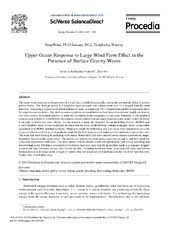| dc.contributor.author | Paskyabi, Mostafa Bakhoday | eng |
| dc.contributor.author | Fer, Ilker | eng |
| dc.date.accessioned | 2014-10-28T12:02:08Z | |
| dc.date.available | 2014-10-28T12:02:08Z | |
| dc.date.issued | 2012 | eng |
| dc.identifier.issn | 1876-6102 | en_US |
| dc.identifier.uri | https://hdl.handle.net/1956/8687 | |
| dc.description.abstract | The upper ocean response in the presence of a wind farm is studied numerically, taking into account the effect of surface gravity waves. The farm geometry is a simplified rigid rectangle with characteristic size of L aligned with the wind direction. Assuming a typical wind deficit behind the farm, an analytical 2D U-shaped wake profile is applied to drive the upper ocean circulation. The shallow-water equations are modified to include farm characteristic length, wind-wave and wave-current momentum transfer to study the circulation in the rectangular ocean basin. Solutions of this modified expression as a function of the Rossby deformation radius confirm that the upper ocean response in the vicinity of a farm is strongly related to the wave effects. For the numerical study, the Regional Ocean Modelling System (ROMS) and a wave-modified finite volume technique are used that the wave-modified finite volume technique shows a reasonable agreement with ROMS simulation results. Numerical results for both linear and non-linear wave simulations show the existence of horizontal shear stress gradients related to the fluid motion, wave-induced stress and farm characteristic size. The wind and wave forcing by including wind stress, Stokes drift and wave-induced stress creates symmetrical, rangedependent dipoles in the upper ocean. The dipoles are sensitive to wind stress, wave forcing and L, and have tendency to become asymmetric with time. The near-surface Ekman current is affected significantly, and strong upwelling and downwelling occur. The linear numerical solver results, however, show that the pycnocline depth as a response of upper ocean to the farm becomes weaker after almost one day. Including non-linear term, horizontal diffusion, and bottom friction leads to a decrease in the strength of eddies. But, the amplitude of disturbances in the lee of the farm becomes weaker after almost three days. | en_US |
| dc.language.iso | eng | eng |
| dc.publisher | Elsevier | en_US |
| dc.relation.ispartof | <a href="http://hdl.handle.net/1956/8692" target="blank">Small-scale turbulence dynamics under sea surface gravity waves</a> | en_US |
| dc.rights | Attribution-NonCommercial-NoDerivs CC BY-NC-ND | eng |
| dc.rights.uri | http://creativecommons.org/licenses/by-nc-nd/3.0/ | eng |
| dc.subject | offshore wind farm | eng |
| dc.subject | surface gravity waves | eng |
| dc.subject | Ekman current | eng |
| dc.subject | upwelling | eng |
| dc.subject | downwelling | eng |
| dc.subject | Stokes drift | eng |
| dc.subject | ROMS | eng |
| dc.title | Upper Ocean Response to Large Wind Farm Effect in the Presence of Surface Gravity Waves | en_US |
| dc.type | Peer reviewed | |
| dc.type | Journal article | |
| dc.description.version | publishedVersion | en_US |
| dc.rights.holder | Copyright 2012 Published by Elsevier Ltd. | en_US |
| dc.identifier.doi | https://doi.org/10.1016/j.egypro.2012.06.106 | |
| dc.identifier.cristin | 942642 | |
| dc.source.journal | Energy Procedia | |
| dc.source.40 | 24 | |
| dc.source.pagenumber | 245-254 | |

